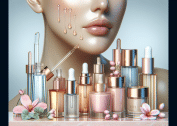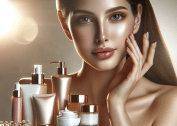Ever wondered if simple self care habits could transform your skin’s radiance? This guide explores the truth behind popular wellness routines, how mindful skincare, hydration, and balanced nutrition intertwine with lasting beauty, and how you can discover gentle rituals that help nurture glowing skin naturally.
Daily Rituals That Support Glowing Skin
The journey to radiant skin often starts with small rituals practiced daily. Consistency matters. Even modest steps, like washing your face twice a day with a gentle cleanser, help maintain a healthy skin barrier. Using a mild, fragrance-free cleanser reduces irritation, protecting the delicate surface of the skin. The ritual of cleansing not only removes dirt and build-up but also prepares the skin for the next beneficial routines, like moisturizer and sunscreen. Over time, these small habits can bring a more luminous look, boosting overall confidence.
Adding a short mindfulness routine can enhance beauty results. Mindfulness practices reduce stress, which plays a major role in skin conditions like acne and eczema. High stress levels increase the release of hormones that can trigger inflammation and make some skin issues worse (Source: https://www.ncbi.nlm.nih.gov/pmc/articles/PMC5919606/). Research highlights that individuals who incorporate brief daily meditation often see improvement in both mood and complexion, making this a worthwhile step in a holistic beauty regimen.
Don’t underestimate the power of sleep in your daily routine. The body undergoes repair and regeneration while you rest, including the skin’s outer layers. Poor sleep is linked to increased skin aging and loss of hydration. A restful night encourages a brighter complexion and reduced puffiness, especially under the eyes. This explains why the idea of “beauty sleep” has persisted for generations—rest is scientifically proven to support lasting skin health (Source: https://www.ncbi.nlm.nih.gov/pmc/articles/PMC5449130/).
Hydration: The Unsung Hero in Wellness
Many wonder if drinking water is truly the secret to hydrated, plump skin. While topical moisturizers help, consuming enough fluids is equally essential. Hydration impacts the skin’s appearance, elasticity, and ability to heal. Experts suggest that dehydration leads to dryness, making the skin appear flaky or dull. Carrying a reusable water bottle and sipping throughout the day is an easy, practical strategy. Ideally, fluids come not only from water but also from natural foods like melon, cucumber, and oranges that are rich in water content.
Hydration from the inside helps maintain a robust skin barrier. When you’re well-hydrated, your skin is more resilient against environmental pollutants and stressors. Moisture loss accelerates the appearance of fine lines and irritation. For those living in dry climates or exposed to indoor heating, using a humidifier at home may offer extra support in keeping skin comfortable and supple. Simple changes in your environment, paired with a steady water intake, can have visible benefits after a few weeks.
Interestingly, hydration also ties into nutrition. Foods containing omega-3 fatty acids, such as walnuts and flaxseed, help lock in moisture by supporting cell membranes (Source: https://www.hsph.harvard.edu/nutritionsource/omega-3-fats/). Consider both water and dietary intake for the most comprehensive approach to skin nourishment. Together, these habits form the core of a hydration routine—not only for beauty, but for holistic wellness as well.
Nutrition’s Influence on Healthy Complexion
What lands on your plate can truly impact your skin’s radiance. Antioxidant-rich foods, such as berries, leafy greens, and bell peppers, provide natural defenses against cellular stress. These nutrients help counteract oxidative damage from pollution, sun exposure, and daily stressors. Rather than relying solely on external creams, those who make smart dietary choices often notice fewer breakouts and more vibrant skin tone. The balanced diet approach is gaining attention in the wellness community for its inside-out benefits.
One often overlooked barrier to beautiful skin is processed sugar. Diets high in refined carbohydrates cause surges in blood glucose, which may contribute to premature skin aging and exacerbate acne (Source: https://www.aad.org/public/diseases/acne/causes/diet). Replacing sugary snacks with whole grains and fiber-rich foods can stabilize energy and support clearer skin. Simple swaps—like oatmeal instead of sweetened cereals—make wellness both sustainable and enjoyable.
Micro-nutrients matter, too. Zinc, vitamin C, and vitamin E are all linked to enhanced skin function and repair. Regularly including citrus fruits, seeds, and nuts in your meals can support collagen synthesis and strengthen skin’s natural barrier (Source: https://ods.od.nih.gov/factsheets/VitaminC-Consumer/). These elements, combined with adequate protein intake, help foster a glowing complexion found in robust wellness habits.
The Connection Between Exercise and Beauty
Regular movement does more than strengthen muscles—it also boosts circulation, delivering more nutrients and oxygen to the skin. Improved circulation supports detoxification and renewal, reducing inflammation and uneven tone. Even short walks, yoga sessions, or dancing at home stimulate blood flow to the face, adding a healthy flush many people desire. Exercise emerges as a significant ally in the pursuit of natural beauty and wellness, providing multiple layers of physical and mental benefits (Source: https://www.ncbi.nlm.nih.gov/pmc/articles/PMC5796020/).
Detoxification is another outcome of movement. As you sweat, your body releases toxins that might otherwise contribute to clogged pores or breakouts. Post-activity skin care is important—cleansing sweat away promptly prevents irritation or buildup. This combination of activity and proper hygiene forms a smart, lasting routine. Exercise-induced endorphins support not just glowing skin, but also a more positive mood, which indirectly boosts beauty by lowering stress hormones.
Over time, regular exercise can reduce the visible signs of aging. Studies have shown that physically active adults often display firmer, more supple skin than those with sedentary habits. The interplay between physical activity, reduced inflammation, and increased cell turnover is well-documented. All styles of movement, from stretching to strength exercises, contribute to radiant skin and well-being. Movement truly integrates body, mind, and the beauty people often seek in themselves.
Sun Protection and Long-Term Skin Health
Protection from the sun remains a key element in maintaining youthful skin. Dermatologists stress the daily use of broad-spectrum sunscreen to ward off premature aging, pigmentation, and cancer risks (Source: https://www.cancer.org/healthy/be-safe-in-sun/sunscreen-and-sun-safety.html). Even on cloudy days, ultraviolet rays reach the skin, causing cumulative damage that might not be noticeable for years. Incorporating sun protection into your morning routine lays a foundation for lasting skin health.
The right coverage extends beyond sunscreen. Protective clothing, hats, and seeking shade during peak sun hours all reduce exposure. Sunglasses shield the fragile skin around the eyes, lowering the risk of wrinkles. Adopting sun-safe habits doesn’t mean avoiding the outdoors; instead, it’s about enjoying time outside without compromising wellness. Consistent sun protection practices can yield clearer, more even skin tone well into maturity.
For individuals with existing sun damage, a combination of preventative and restorative routines is advised. Seeking professional guidance for hyperpigmentation, considering vitamin C serums, and regular moisturizing help fade sun-induced spots over time. Being proactive with sun safety, rather than waiting to see effects, preserves both beauty and overall skin integrity—making this habit a pillar of long-term self care success.
Mental Wellness as a Core Beauty Factor
Emotional well-being and skin health share a complex relationship. Studies show that individuals with consistent self care routines—like journaling, meditation, or connecting with others—experience fewer breakouts and signs of aging. The stress response can trigger inflammation, leading to dull complexion and flare-ups. Relaxation techniques, gratitude practices, and regular check-ins with mental health all fall under the umbrella of beauty from within (Source: https://www.mind.org.uk/information-support/tips-for-everyday-living/wellbeing/wellbeing/).
Loneliness or constant negative self-talk can erode wellness from the inside, showing up externally in ways many people don’t realize. Building a supportive network, seeking uplifting activities, and expressing creativity are all forms of nourishment for the psyche—and by extension, the skin. A balanced and joyful mindset contributes to open, relaxed facial features and more vibrant eyes, supporting the notion that happiness truly radiates outward.
Those interested in lasting beauty should view well-being as a whole, not just as separate diet, skincare, or exercise efforts. Practice self-compassion, take time for rest, and invite curiosity about what helps you feel best. Over time, this approach leads to confidence and radiance rooted in authentic wellness, rather than fleeting achievements. The secret to glowing skin, it seems, lives as much in the mind as it does in the mirror.
References
1. American Academy of Dermatology. (n.d.). How diet and nutrition affect your skin. Retrieved from https://www.aad.org/public/diseases/acne/causes/diet
2. Harvard T.H. Chan School of Public Health. (n.d.). Omega-3 fats. Retrieved from https://www.hsph.harvard.edu/nutritionsource/omega-3-fats/
3. Mind. (n.d.). How to improve your mental wellbeing. Retrieved from https://www.mind.org.uk/information-support/tips-for-everyday-living/wellbeing/wellbeing/
4. National Institutes of Health. (n.d.). Vitamin C: Fact sheet for consumers. Retrieved from https://ods.od.nih.gov/factsheets/VitaminC-Consumer/
5. American Cancer Society. (n.d.). Sunscreen and sun safety. Retrieved from https://www.cancer.org/healthy/be-safe-in-sun/sunscreen-and-sun-safety.html
6. U.S. National Library of Medicine. (n.d.). Cortisol and the skin: A review. Retrieved from https://www.ncbi.nlm.nih.gov/pmc/articles/PMC5919606/









